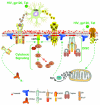Converging roles for sphingolipids and cell stress in the progression of neuro-AIDS
- PMID: 18508574
- PMCID: PMC2739118
- DOI: 10.2741/3068
Converging roles for sphingolipids and cell stress in the progression of neuro-AIDS
Abstract
Sphingolipids are a class of lipids enriched in the central nervous system that have important roles in signal transduction. Recent advances in our understanding of how sphingolipids are involved in the control of life and death signaling have uncovered roles for these lipids in the neuropathogenesis of HIV-associated neurocognitive disorders (HAND). In this review we briefly summarize the molecular mechanisms involved in the pathological production of the toxic sphingolipid, ceramide and address questions of how cytokine and cellular stress pathways that are perturbed in HAND converge to deregulate ceramide-associated signaling.
Figures


Similar articles
-
Novelty of Sphingolipids in the Central Nervous System Physiology and Disease: Focusing on the Sphingolipid Hypothesis of Neuroinflammation and Neurodegeneration.Int J Mol Sci. 2021 Jul 8;22(14):7353. doi: 10.3390/ijms22147353. Int J Mol Sci. 2021. PMID: 34298977 Free PMC article. Review.
-
Sphingolipids--the enigmatic lipid class: biochemistry, physiology, and pathophysiology.Toxicol Appl Pharmacol. 1997 Jan;142(1):208-25. doi: 10.1006/taap.1996.8029. Toxicol Appl Pharmacol. 1997. PMID: 9007051 Review.
-
Roles for dysfunctional sphingolipid metabolism in Alzheimer's disease neuropathogenesis.Biochim Biophys Acta. 2010 Aug;1801(8):878-86. doi: 10.1016/j.bbalip.2010.05.003. Epub 2010 May 7. Biochim Biophys Acta. 2010. PMID: 20452460 Free PMC article. Review.
-
Sphingolipids in apoptosis, survival and regeneration in the nervous system.Biochim Biophys Acta. 2006 Dec;1758(12):1995-2015. doi: 10.1016/j.bbamem.2006.09.018. Epub 2006 Sep 26. Biochim Biophys Acta. 2006. PMID: 17084809 Review.
-
Sphingolipids as Regulators of Neuro-Inflammation and NADPH Oxidase 2.Neuromolecular Med. 2021 Mar;23(1):25-46. doi: 10.1007/s12017-021-08646-2. Epub 2021 Feb 5. Neuromolecular Med. 2021. PMID: 33547562 Free PMC article. Review.
Cited by
-
Cambinol, a novel inhibitor of neutral sphingomyelinase 2 shows neuroprotective properties.PLoS One. 2015 May 26;10(5):e0124481. doi: 10.1371/journal.pone.0124481. eCollection 2015. PLoS One. 2015. PMID: 26010541 Free PMC article.
-
Sphingosine kinase 1 and sphingosine-1-phosphate in oxidative stress evoked by 1-methyl-4-phenylpyridinium (MPP+) in human dopaminergic neuronal cells.Mol Neurobiol. 2014 Aug;50(1):38-48. doi: 10.1007/s12035-013-8622-4. Epub 2014 Jan 9. Mol Neurobiol. 2014. PMID: 24399507
-
Tryptophan, Neurodegeneration and HIV-Associated Neurocognitive Disorder.Int J Tryptophan Res. 2010;3:121-40. doi: 10.4137/ijtr.s4321. Epub 2010 Jun 10. Int J Tryptophan Res. 2010. PMID: 22084594 Free PMC article.
-
Neurodegeneration and ageing in the HAART era.J Neuroimmune Pharmacol. 2009 Jun;4(2):163-74. doi: 10.1007/s11481-008-9143-1. Epub 2008 Dec 6. J Neuroimmune Pharmacol. 2009. PMID: 19067177 Review.
-
Chronic low-level expression of HIV-1 Tat promotes a neurodegenerative phenotype with aging.Sci Rep. 2017 Aug 10;7(1):7748. doi: 10.1038/s41598-017-07570-5. Sci Rep. 2017. PMID: 28798382 Free PMC article.
References
-
- France-Lanord V, Brugg B, et al. Mitochondrial free radical signal in ceramide-dependent apoptosis: a putative mechanism for neuronal death in Parkinson's disease. J Neurochem. 1997;69(4):1612–21. - PubMed
-
- Cutler RG, Pedersen WA, et al. Evidence that accumulation of ceramides and cholesterol esters mediates oxidative stress-induced death of motor neurons in amyotrophic lateral sclerosis. Ann Neurol. 2002;52(4):448–57. - PubMed
-
- Haughey NJ, Cutler RG, et al. Perturbation of sphingolipid metabolism and ceramide production in HIV-dementia. Ann Neurol. 2004;55(2):257–67. - PubMed
-
- Charles R, Sandirasegarane L, et al. Ceramide-coated balloon catheters limit neointimal hyperplasia after stretch injury in carotid arteries. Circ Res. 2000;87(4):282–8. - PubMed
Publication types
MeSH terms
Substances
Grants and funding
LinkOut - more resources
Full Text Sources
Medical
